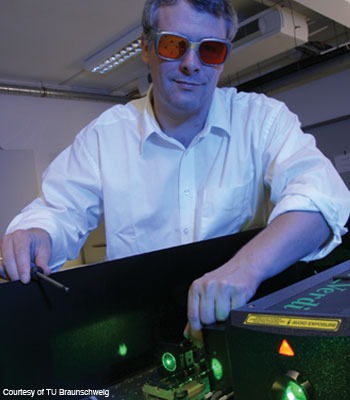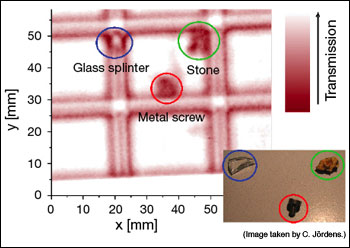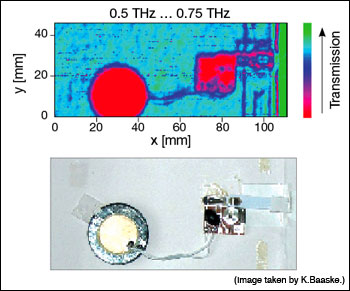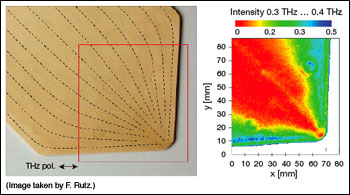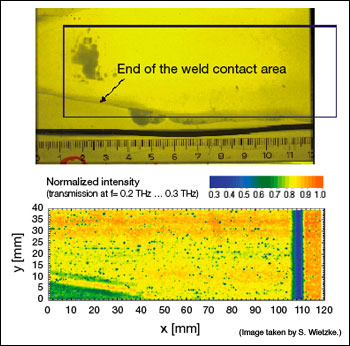By the year 2020, terahertz (THz) systems will widen our technical potential to a similar extent that X-ray scanners did over the past hundred years. In comparison to X-ray systems, which have come a long way since their first demonstration in 1895, systems based on non-ionizing THz waves are still in their infancy. The THz frequency range includes frequencies between 100 GHz and 10 THz. The initial experiments in this area were performed in the first half of the 20th century. However, the pace of THz research didn’t really pick up until the advent of reliable femtosecond lasers and THz time-domain spectroscopy. In some sense, we arrived only very recently at the shore of a newly discovered land that stretches before us. There have been many expeditions during the last 10 years, but most of what we face is uncharted territory. We still have only a vague idea about the areas in which THz systems will have succeeded by 2020 and how the technology will develop. Terahertz sourcesThe list of THz sources is already quite long. It starts with emitters, which are based on undulated electron beams. These include synchrotrons, free-electron lasers, Smith-Purcell emitters and backward-wave oscillators. None of these are very practical because they are bulky and expensive. THz emitters can also be realized using microwave technology based on Gunn, Impatt or resonant tunneling diodes. The fundamental emission frequencies of these purely electronic devices mostly need to be multiplied in special mixers. Although a microwave-based THz source can easily fit into a shoe box, its costs are typically in the tens of thousands of dollars. Molecular gas lasers can emit several milliwatts of power at discrete THz frequencies. They rely on transitions between different rotational levels of a molecular species. Since this kind of laser must be optically pumped by a tunable carbon dioxide laser, the entire system is, again, cumbersome and costly. Optoelectronic sources are more compact and affordable. They can be divided into two classes: semiconductor lasers, which directly emit THz waves, and sources, which use the emission of an optical laser to gate an optoelectronic switch. The first class includes lead salt lasers, which rely on interband transitions in lead-containing semiconductors—PbSe, for example. They are good sources for higher THz frequencies but are somewhat out of fashion. P-germanium lasers, which were introduced in the early 1980s, use hole transitions from the light hole to the heavy hole band and deliver strong THz pulses that can be tuned in frequency. Yet, the p-germanium laser requires a magnetic field for operation. Quantum cascade lasers (QCLs) are very promising. First demonstrated in 1994, they rely on the emission from transitions between subbands in a quantum well. When a voltage is applied to a complicated sequence of repeating quantum well structures, electrically injected electrons stream down a potential staircase and emit a THz photon at each step. Early QCLs emitted in the mid-infrared. However, in 2002, Tredicucci and co-workers presented a QCL working at 4.4 THz. Today, we have seen QCLs with operating frequencies below 1.5 THz. Although these direct optoelectronic THz sources require cryogenic cooling, portable lightweight THz sources can be built using closed-cycle Stirling coolers, especially with QCLs. The second class of optoelectronic sources made a big step with the development of reliable femtosecond titanium:sapphire lasers in the early 1990s. Meanwhile, many schemes have been demonstrated to generate and detect THz pulses using optical femtosecond laser pulses. The oldest and probably most popular approach involves photoconductive dipole antennas, which are gated by the pulses. These antennas consist of a semiconducting substrate, mostly GaAs or low-temperature-grown (LT) GaAs, onto which a metallic antenna structure is deposited in a photolithographic process. An external bias is applied to the antenna structure. It comprises a small gap that prevents a short. A current can only flow under the action of a laser pulse, which optically excites the semiconducting antenna substrate in the gap. The generated electron-hole pairs are accelerated in the bias field and cause a short current pulse with a sub-picosecond rise time. According to Maxwell’s law, this is the source for a short and, hence, broadband THz impulse. The continuous-wave-power level is typically in the microwatt range. In a THz spectrometer, this THz pulse is detected background-free with a second antenna of similar design, which, again, is gated by a femtosecond pulse. This generation-detection scheme is very powerful and often used for THz time-domain spectroscopy. It is also well suited for imaging. Due to the pulsed nature of the THz radiation, and in close analogy to ultrasound or optical coherence tomography systems, internal voids or interfaces can be visualized. Since the THz pulses are broadband, even spectroscopic information on the imaged object can be obtained. |
Of course, titanium:sapphire lasers, which emit femtosecond pulses between 700 and 1,000 nm, still have their price. Femtosecond fiber lasers with emission wavelengths around 1,064 and 1,550 nm are also available. They are somewhat less expensive but call for new semiconductor materials with a lower band gap because of the longer emission wavelength. Lately, good progress has been made using LT-GaAsSb, LT-InGaAs, LT-GaAsBi and Fe-implanted InGaAs. Alternatively, nonlinear crystals can be used. A cost-effective alternative, which also falls in the second class, is photomixer-based systems. Here, the femtosecond laser is replaced by two single-mode diode lasers with slightly different emission frequency or a single laser operating on two lines simultaneously. The emission of these lasers is superimposed again on a photoconductive antenna. The resulting light beat is converted into an oscillating antenna current, which is the source for a monochromatic THz wave. As in the pulsed case, the power level of this continuous-wave radiation is in the microwatt range. Again, the THz wave can be detected coherently and background-free by a second antenna. Although this scheme is sufficient for simple industrial applications, it is less powerful than time-domain spectroscopy, because images are typically obtained only at one fixed frequency. To derive tomographic information, lengthy frequency scans would become necessary. THz detectorsThe list of THz receivers is somewhat shorter. Coherent detection using photoconductive antennas is very powerful. In addition, one can use Schottky mixers, which embody classical microwave technology, or superconductor-insulator-superconductor mixers, which require cryogenic cooling and are often used as heterodyne detectors in radio astronomy. There are also detectors based on the heat generated by the incident THz radiation. This class includes Golay cells, pyrometers and a variety of bolometers. Golay cells, which cost several thousand dollars and use the heat-induced expansion of a gas, are currently not produced and out of stock. Costing just a few dollars, pyrometers are much cheaper but are not very responsive. Very sensitive bolometers also need liquid helium temperatures to operate. Furthermore, there are several detector schemes based on more or less exotic semiconductor effects. In addition to these single-pixel detectors, two-dimensional detector arrays are currently under development, predominantly for military and security applications. Most of them are based on highly developed microwave technology at a few hundred GHz. Higher THz frequencies can be detected with room-temperature micro-bolometer arrays for the mid-infrared. These cameras have been shown to hold a small residual sensitivity at THz frequencies. Hence, a powerful THz source such as a gas laser or QCL is required for illumination. Finally, many optical components are being developed for the THz range. Traditionally, plane and curved metal surfaces have been used to reflect and focus THz waves. In recent years, however, several approaches have emerged for developing a variety of quasi-optical components from dielectric materials. These components include mirrors, filters, lenses and waveguides. Applications for THz imaging systemsIn a few years from now, microwave-based cameras will likely become fixtures in many airports. They will be used to search for concealed and suspicious objects on fully clothed airline passengers. This will become possible because low-frequency THz waves have the capability of penetrating most textiles, while water-containing objects—including the human body—are impenetrable and reflect the waves. At present, several companies are intensively developing this type of security camera and working to improve imaging speed and quality. Microwave-based arrays are also being developed for military purposes. They are being used to detect hostile targets even under bad weather conditions. In the civilian sector, this technology may play a role in landing aids for aircraft. These microwave systems are not optical or optoelectronic systems in the classical sense. A mature THz technology will take spectroscopic investigations to the next level, allowing explorations of rotational transitions of polar molecules in the gas phase and vibrational modes of crystals and biological macromolecules. Although almost all classes of materials have been spectroscopically investigated, including semiconductors, metals, superconductors, insulators, polymers, biomolecules, explosives, drugs, liquids, gases and metamaterials, material characterization is ongoing and the catalogue of substances to be studied is nearly endless. Applications for imaging systems based on THz time-domain spectroscopy may be used for security checks for luggage or mail. The top image in the figure above shows the THz transmission image of a battery, circuit and speaker—which, together, form a device that is used in a musical greeting card to play music when the card is opened. Although the device is hidden inside an envelope, the THz waves render it clearly visible. Although detecting metallic parts inside a paper envelope may seem trivial, it becomes very important when the object to be uncovered is not a music-playing device but a detonator for a mail bomb (which may look very similar). Researchers are also discussing if it is possible to identify drugs and explosives in an envelope or package using spectroscopic fingerprints. Although first experiments look very promising, this undertaking is challenging because the spectra may be masked by the absorption of other items in the beam patch and by interferences arising from the multitude of interfaces that a probing THz beam experiences. THz waves could also play a role in diagnosing skin diseases. (Because THz waves cannot penetrate more than a few hundred micrometers of human tissue, their use is restricted to an investigation of the body surface.) Research has indicated that pulsed THz imaging may have the potential to distinguish between basal cell carcinoma and other skin irregularities. Dermatologists have not shown much interest in this technology, however, mainly due to the high price of pulsed THz systems. |
THz images of teeth have been shown in the press. These were mostly obtained from extractions that were cut in slices and then dried. The reality is that living teeth in a jaw cannot be penetrated by THz waves because the water content is too high. (Polar liquids, such as water and alcohol, and conducting materials are not transparent THz materials.) All told, it is doubtful that a significant market potential exists for THz technology in the area of medical diagnostics. Rather, the biggest mid-term potential of THz imaging systems lay in various inspection applications for the polymer industry. Typically, the properties of polymers are altered according to the customers’ demand by mixing them with additives. To achieve the desired physical properties with a minimal amount of additives, an optimum dispersion is required. Recent research has shown that the additive content and dispersion can be precisely determined in polymers that are opaque visibly and in the near- and mid-infrared using THz time-domain systems. The THz group at the Technical University of Braunschweig, Germany, is currently developing a THz system for the in-line control of polymeric compounding processes. One can also visualize the structure of textured materials, which are mostly birefringent. A typical material class is liquid crystal polymers, which are widely used for structural applications in the automobile and aviation industries. The left portion of the figure below is a photograph of a helicopter stator made from an LCP composite containing glass fibers. The superimposed black lines indicate the expected orientation of the LCP molecules and glass fibers. The birefringence leads to an ordinary and extraordinary ray, the latter of which experiences a higher refractive index. If the polarization of the THz pulse is not oriented purely parallel or orthogonal with respect to the LCP molecules, the detected THz signal contains both contributions—i.e., two slightly delayed pulses. In a certain frequency band (here 0.3 to 0.4 THz), this leads to a destructive interference that shows up in the THz transmission image (the right portion of the figure). With a more sophisticated data extraction algorithm (which is currently being worked on), it will be possible to map out the LCP orientation exactly.
Many polymers are widely used for construction purposes, since they can be produced inexpensively in large numbers by extrusion or injection molding. One common method of joining plastics is welding. However, pores from contaminations, air bubbles or delaminations can reduce the joint strength, leading to a dramatic loss of structural integrity. Since welding is normally placed at the end of the value THz imaging is ideally suited for the inspection of plastic welding joints. When two plates of translucent polyethylene are welded together, the optical transparency allows for a comparison between the THz and the visual images. Moreover, sand or other particles can be clearly detected in polymers that are not transparent in the visible, near- and mid-infrared. Recently, the plates of insulating foam that cover the fuel tank of the space shuttle have been extensively searched with THz imaging for voids and defects to enhance security. Looking aheadDue to the high potential of time-domain THz imaging systems, several companies are already offering these products. Some of the important players in this technology are Picometrix (United States), Teraview (United Kingdom), Nikon and Aispec (Japan).
Yet, even with the fastest commercial systems, an image of an extended object such as a chocolate bar takes a few minutes to obtain. This is not fast enough for industrial applications. The chocolate industry requires one chocolate bar to be inspected in 0.1 s—which corresponds to a translation speed A similar imaging speed is also required in the polymer and wood industries. Hence, researchers are focusing on achieving these imaging speeds as well as on making THz imaging systems more cost-effective. Preliminary tests in Braunschweig have shown that the stipulated measurement speeds can be met. Efficient and inexpensive room-temperature THz sources and detectors are also still lacking. In addition, many passive devices, such as filters, reflectors and waveguides, must be developed. All this is good news for scientists and engineers looking to stake their claim in this undiscovered country. The author would like to thank Kai Baaske, Christian Jördens, Frank Rutz and Steffen Wietzke for taking the THz images presented in this article. Martin Koch is with the Institute for High-Frequency Technology at the Technical University at Brunswick (Braunschweig) in Brunswick, Germany.
References and Resources
>> S. Hunsche et al. New Dimensions in T-Ray Imaging, IEICE Trans. Electron. E81-C, 269 (1998). |

